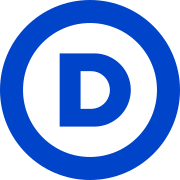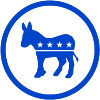Our website is made possible by displaying online advertisements to our visitors.
Please consider supporting us by disabling your ad blocker.
Democratic Party (United States)
The United States Democratic Party is one of the two biggest political parties in the United States. Since the mid-1850's, the party's main opponent has been the Republican Party. Both political parties have controlled American politics ever since.
- ↑ "About the Democratic Party". Democrats. March 4, 2019. Archived from the original on April 6, 2022. Retrieved April 15, 2022.
For 171 years, [the Democratic National Committee] has been responsible for governing the Democratic Party
- ↑ Democratic Party (March 12, 2022). "The Charter & The Bylaws of the Democratic Party of the United States" (PDF). p. 3. Archived (PDF) from the original on March 27, 2022. Retrieved April 15, 2022.
The Democratic National Committee shall have general responsibility for the affairs of the Democratic Party between National Conventions
- ↑ Cole, Donald B. (1970). Jacksonian Democracy in New Hampshire, 1800–1851. Harvard University Press. p. 69. ISBN 978-0-67-428368-8.
- ↑ Cite error: The named reference
sarnoldwas used but no text was provided for refs named (see the help page). - ↑ Cite error: The named reference
Harry Entenwas used but no text was provided for refs named (see the help page). - ↑ Bacon, Perry Jr. (March 11, 2019). "The Six Wings Of The Democratic Party". FiveThirtyEight. Archived from the original on August 15, 2021. Retrieved October 21, 2021.
- ↑ Stein, Letita; Cornwell, Susan; Tanfani, Joseph (August 23, 2018). "Inside the progressive movement roiling the Democratic Party". Reuters. Archived from the original on June 13, 2022. Retrieved June 13, 2022.
- ↑ Rae, Nicol C. (June 2007). "Be Careful What You Wish For: The Rise of Responsible Parties in American National Politics". Annual Review of Political Science. 10 (1). Annual Reviews: 169–191. doi:10.1146/annurev.polisci.10.071105.100750. ISSN 1094-2939.
What are we to make of American parties at the dawn of the twenty-first century? ... The impact of the 1960s civil rights revolution has been to create two more ideologically coherent parties: a generally liberal or center-left party and a conservative party.
- ↑ Cronin, James E.; Ross, George W.; Shoch, James (August 24, 2011). "Introduction: The New World of the Center-Left". What's Left of the Left: Democrats and Social Democrats in Challenging Times. Duke University Press. ISBN 978-0-8223-5079-8. Archived from the original on August 20, 2024. Retrieved August 7, 2024. pp. 17, 22, 182:
Including the American Democratic Party in a comparative analysis of center-left parties is unorthodox, since unlike Europe, America has not produced a socialist movement tied to a strong union movement. Yet the Democrats may have become center-left before anyone else, obliged by their different historical trajectory to build complex alliances with social groups other than the working class and to deal with unusually powerful capitalists ... Taken together, the three chapters devoted to the United States show that the center-left in America faces much the same set of problems as elsewhere and, especially in light of the election results from 2008, that the Democratic Party's potential to win elections, despite its current slide in approval, may be at least equal to that of any center-left party in Europe ... Despite the setback in the 2010 midterms, together the foregoing trends have put the Democrats in a position to eventually build a dominant center-left majority in the United States.
- ↑ Bruner, Christopher (January 1, 2018). "Center-Left Politics and Corporate Governance: What Is the 'Progressive' Agenda?". Brigham Young University Law Review: 267–338.
While these dynamics have remained have remained important to the Democratic Party's electoral strategy since the 1990s, the finance-driven coalition described above remains high controverisal and unstable, reflecting the fact that core intellectual and ideological tensions in the platform of the U.S. center-left persist.
- ↑ Hacker, Jacob S.; Malpas, Amelia; Pierson, Paul; Zacher, Sam (December 27, 2023). "Bridging the Blue Divide: The Democrats' New Metro Coalition and the Unexpected Prominence of Redistribution". Perspectives on Politics. 22 (3). Cambridge University Press on behalf of the American Political Science Association: 3. doi:10.1017/S1537592723002931. ISSN 1537-5927.
We conclude by considering why Democrats have taken this course, why they are not perceived as having done so, and why, at this fraught juncture for American democratic capitalism, political scientists could learn much from closer examination of the rich world's largest center-left party.
- ↑ Zacher, Sam (June 2024). "Polarization of the Rich: The New Democratic Allegiance of Affluent Americans and the Politics of Redistribution". Perspectives on Politics. 22 (2): 338–356. doi:10.1017/S1537592722003310.
It is clear that the Democratic Party—the center-left United States political party—does enact some forms of a redistributive economic policy agenda.
- ↑ Galston, Willim (November 30, 2023). "What Today's Working Class Wants from Political Leaders". International Journal of Comparative Studies in International Relations and Development. 9 (1): 105–109. doi:10.48028/iiprds/ijcsird.v9.i1.07.
The exit of the working class from the Democratic Party is a long saga that began in the late 1960s and culminated in Donald Trump's takeover of the Republican Party with themes that resonated among working class voters. During this period, Democrats along with center-left parties through Western democracies who have encountered similar difficulties have struggled to understand the sources of working-class disaffection and to craft remedies for it.
- ↑ [8][9][10][11][12][13]
- ↑ Coates, David, ed. (2012). "Liberalism, Center-left". The Oxford Companion to American Politics. Oxford University Press. pp. 68–69. doi:10.1093/acref/9780199764310.001.0001. ISBN 978-0-19-976431-0.
<ref group=lower-alpha> tags or {{efn}} templates on this page, but the references will not show without a {{reflist|group=lower-alpha}} template or {{notelist}} template (see the help page).
Previous Page Next Page
Demokratiese Party (Verenigde State) AF Demokratische Partei (USA) ALS ዴሞክራቲክ ፓርቲ (አሜሪካ) AM الحزب الديمقراطي (الولايات المتحدة) Arabic ܓܒܐ ܕܝܡܘܩܪܛܝܐ (ܐܘܚܕܢܐ ܡܚܝܕܐ) ARC الحزب الديموقراطى فى امريكا ARZ Partíu Demócrata (Estaos Xuníos) AST Demokratlar Partiyası (ABŞ) AZ دموکرات حیزبی (بیرلشمیش ایالتلر) AZB Partai Démokrat (Amérika Serikat) BAN




